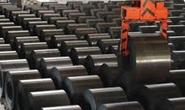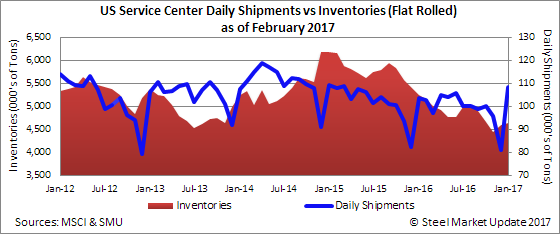Steel Mills

Steel Distributors Flat Rolled Inventories Fall as Shipments Improve
Written by John Packard
February 16, 2017
The Metal Service Center Institute (MSCI) released shipment and inventories data for the steel service centers located in the United States. They reported higher shipment rates coupled with lower flat rolled inventories (higher overall for all products) which is very supportive for prices to tighten over the next 30 days.
U.S. steel service centers (all products) shipped a total of 3,340,400 tons during the month of January. This total for shipments is 9.4 percent above year ago levels. The 9.4 percent increase year-over-year is the largest increase we have seen in a long time. During 2016 there were only two months of positive growth YOY, November at 3.3 percent and August at 2.1 percent. The daily average shipment rate was 159,100 tons per day.
Inventories stood at 7,296,500 tons at the end of January, an increase of 71,100 tons from the end of December levels. Inventories are now 8.3 percent lower than year ago levels and the number of month’s supply (all products) stands at 2.2 months compared to 2.8 months at the end of December.
Carbon Flat Rolled
Distributors shipped 2,273,300 tons of carbon flat rolled or “sheet” products during the month of January. Shipments were up 201,800 tons compared to year ago levels and 577,600 tons greater than December 2016. Sheet shipments were 9.7 percent higher than last year.
Flat rolled inventories totaled 4,625,100 tons which are slightly higher than December’s 4,595,300 tons and 11.8 percent below year ago levels.
The number of month’s supply stands at 2.0 months compared to the 2.7 month’s supply reported by the MSCI at the end of December 2016.
The MSCI reported hot rolled inventories as being 2.20 months, this is down from over 3.0 months just a few months back. Cold rolled months supply is now at 1.89 months and coated (galvanized/Galvalume) are at 1.75 months up only slightly from the 1.69 months just a few months back.
Assuming the MSCI data is correct then inventories are very tight and the orders on the books will not radically change that scenario if the AISI raw steel production data is anywhere near close to be accurate.
Carbon Plate
Plate shipments totaled 291,800 tons during the month of January. Shipments of plate were 9.3 percent higher than year ago levels. The daily shipment rate was 13,900 tons per day compared to 13,400 tons per day one year ago and 11,600 tons per day reported at the end of December.
Plate inventories increased slightly from 722,500 tons at the end of December to 737,400 tons at the end of January. Inventories are 0.3 percent lower than year ago levels and the number of month’s supply dropped dramatically from 3.0 months at the end of January to 2.5 month.
Carbon Pipe & Tube
Pipe and tube shipments out of the U.S. service centers stood at 194,800 tons at the end of January. This is 2.2 percent better than year ago levels.
Inventories of pipe & tube stood at 471,500 tons which is 18 percent lower than year ago levels. The number of month’s supply stood at 2.4 months at the end of January. This is down from the 2.8 months at the end of December.

John Packard
Read more from John PackardLatest in Steel Mills

Nucor names Batterbee, Bledsoe to HR roles
Nucor Corp. has promoted Thomas J. Batterbee to the position EVP of human resources and talent and appointed Elizabeth Bledsoe to the newly created position of president of human resources and talent.

Millett sees tariffs, CORE case benefiting SDI
Steel Dynamics' top exec thinks Trump’s tariff policies, as well as the results from the recent CORE case, will prove advantageous to the Fort Wayne, Ind.-based steelmaker and aluminum company.

USW digs in on opposition to USS-Nippon deal
“We remain deeply concerned about the national and economic security implications of the subject transaction,” the union stated in the letter dated April 21.

SDI’s Q1 earnings slump on-year, but up sequentially
SDI earnings slip in first quarter year over year, but are up sequentially.

POSCO inks MoU with Hyundai on Louisiana EAF mill
POSCO has signed a Memorandum of Understanding (MoU) with Hyundai Motor Group that includes an equity investment in Hyundai’s previously announced EAF mill set to be built in Louisiana.

